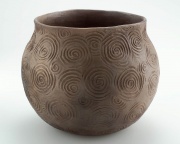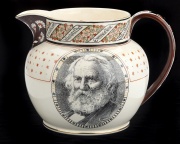Difference between revisions of "Earthenware"
Jump to navigation
Jump to search
m (Text replace - "== Authority ==" to "== Sources Checked for Data in Record ==") |
|||
| Line 1: | Line 1: | ||
| − | [[File:1994.46-SC43384.jpg|thumb|]] | + | [[File:1994.46-SC43384.jpg|thumb|Native American bowl<br>MFA# 1994.46]] |
== Description == | == Description == | ||
| − | + | [[File:2000.697-SC43387.jpg|thumb|"Longfellow" pitcher<br>MFA# 2000.697]] | |
A coarse, opaque, baked pottery. Earthenware is probably the earliest kind of ceramics and was made in Turkey as early as 8000 BCE. It is typically made from secondary clays and fired at relatively low temperatures of 800-1200 C. Unglazed earthenware is porous. Soft or semi-hard glazes were used on earthenware starting about 3000 BCE by the Egyptians. Examples of tin-glazed earthenware are [[faience]], [[delftware]], and [[majolica]]. Earthenware is used to make brick, tiles, and [[terracotta]] objects. | A coarse, opaque, baked pottery. Earthenware is probably the earliest kind of ceramics and was made in Turkey as early as 8000 BCE. It is typically made from secondary clays and fired at relatively low temperatures of 800-1200 C. Unglazed earthenware is porous. Soft or semi-hard glazes were used on earthenware starting about 3000 BCE by the Egyptians. Examples of tin-glazed earthenware are [[faience]], [[delftware]], and [[majolica]]. Earthenware is used to make brick, tiles, and [[terracotta]] objects. | ||
| − | |||
| − | |||
== Synonyms and Related Terms == | == Synonyms and Related Terms == | ||
| Line 10: | Line 8: | ||
faience; faïence (Fr.); faiança (Port.); delft; majolica; terracotta | faience; faïence (Fr.); faiança (Port.); delft; majolica; terracotta | ||
| − | == | + | ==Resources and Citations== |
* ''The Dictionary of Art'', Grove's Dictionaries Inc., New York, 1996 Comment: "Ceramics" | * ''The Dictionary of Art'', Grove's Dictionaries Inc., New York, 1996 Comment: "Ceramics" | ||
| Line 16: | Line 14: | ||
* Ralph Mayer, ''A Dictionary of Art Terms and Techniques'', Harper and Row Publishers, New York, 1969 (also 1945 printing) | * Ralph Mayer, ''A Dictionary of Art Terms and Techniques'', Harper and Row Publishers, New York, 1969 (also 1945 printing) | ||
| − | * ''Encyclopedia Britannica'', http://www.britannica.com Comment: "Earthenware." | + | * ''Encyclopedia Britannica'', http://www.britannica.com Comment: "Earthenware." Accessed 18 Aug. 2004. |
* ''The American Heritage Dictionary'' or ''Encarta'', via Microsoft Bookshelf 98, Microsoft Corp., 1998 | * ''The American Heritage Dictionary'' or ''Encarta'', via Microsoft Bookshelf 98, Microsoft Corp., 1998 | ||
Latest revision as of 11:42, 1 August 2022
Description
A coarse, opaque, baked pottery. Earthenware is probably the earliest kind of ceramics and was made in Turkey as early as 8000 BCE. It is typically made from secondary clays and fired at relatively low temperatures of 800-1200 C. Unglazed earthenware is porous. Soft or semi-hard glazes were used on earthenware starting about 3000 BCE by the Egyptians. Examples of tin-glazed earthenware are Faience, Delftware, and Majolica. Earthenware is used to make brick, tiles, and Terracotta objects.
Synonyms and Related Terms
faience; faïence (Fr.); faiança (Port.); delft; majolica; terracotta
Resources and Citations
- The Dictionary of Art, Grove's Dictionaries Inc., New York, 1996 Comment: "Ceramics"
- Ralph Mayer, A Dictionary of Art Terms and Techniques, Harper and Row Publishers, New York, 1969 (also 1945 printing)
- Encyclopedia Britannica, http://www.britannica.com Comment: "Earthenware." Accessed 18 Aug. 2004.
- The American Heritage Dictionary or Encarta, via Microsoft Bookshelf 98, Microsoft Corp., 1998

